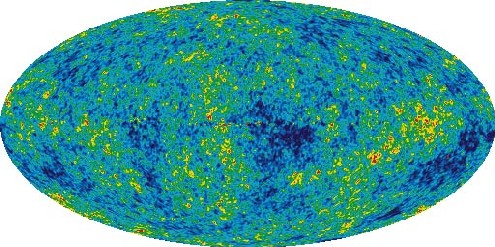
Credit: NASA/WMAP Science Team
By James Dacey
In my view, the real beauty of blogging is that it allows for a more free-flowing form of journalism in which the reporter brings him / her self into the story. If done well, a good blogger should be able to convey not only the news but also their experience of the news as it is happening.
Academic presentations are a favourite subject of science bloggers but what happens if one of the “protagonists” feels that the blogger has not quite grasped all the subtleties of their argument? Should the blogger go back and add more layers to their post or does this defeat the whole point of blogging – removing the personal touch and converting it into a more polished article all in one editorial concession?
Last Tuesday I went to Imperial College, London to watch a highly entertaining public debate on the small topic of “The Fate of the Universe”. On the train journey home my head was still spinning with some of the huge ideas so I decided to rattle off a blog about the event and my experience of attending of it.
Since publishing this blog I have been contacted by one of the speakers Subir Sarkar of Oxford University who enjoyed reading the blog BUT felt that it didn’t quite portray the full depth of his argument. Therefore, to keep in the spirit of blogging whilst doing full justice to Sarkar’s debate-winning presentation, we have agreed that the best solution is to publish these clarifications as a new blog post. And here it is:
Dear James,
I hope you don’t mind my pointing this out (it is your blog!) but the technical points you report are slightly different from what I actually said in two important respects.
Firstly, the large cosmological constant (aka vacuum energy) is predicted not by quantum mechanics but by quantum field theory (the union of qm and special relativity) when coupled to gravity as described by Einstein’s general relativity. Clearly something must give – either Einstein’s theory must be modified and/or there must be a mechanism that cancels the huge vacuum energy. No one has been able to figure out how … but Nature must know the trick otherwise we would not be here talking about it! Until we figure it out we ought to be wary of naively invoking (a relatively tiny) vacuum energy to explain cosmological observations.
Secondly, the observations may well be right but the inference of a cosmological constant (in terms of the present – probably oversimplified – cosmological model) may be wrong. No one has actually seen acceleration – this is inferred from the observation that distant supernovae are slightly fainter than would be expected for a decelerating universe. But this inference is based on the assumption of homogeneity – what if we are in a void that is expanding faster than the average rate so that distant supernovae are in a slower Hubble flow relative to the local ones and this creates the illusion of acceleration?
Also the 10122 number was quoted by Andrew, while I said 1060 since this is the expectation from the Standard Model of particle physics – our most successful quantum field theory – which has been verified to work very well up to energies of ~103 GeV. If QFT holds all the way up to the Planck scale of 1019 GeV then we would get the extra (1016)4 ~ 1064 factor (of course all these numbers are so huge that it does not really matter). My point was that Nature must have somehow solved this problem, otherwise the universe would have never got bigger than a mm (before becoming vacuum energy dominated). Interestingly enough, Wolfgang Pauli had apparently estimated that the universe “could not even reach to the moon” from a similar argument by taking the ‘cut-off energy’ to be the electron mass – this calculation was reproduced recently by Prof Norbert Straumann of Zurich. So Pauli concluded that vacuum energy does not gravitate (“as is evident from experience”) – but he did not explain why!
I am glad you liked Rachel Thomas’s article in Plus Magazine – I thought she did a great job of communicating the essential puzzles about the cosmological constant problem.
Best – Subir



